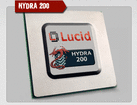Wednesday, September 23rd 2009

LucidLogix Fires up Multi-GPU Computing With Faster, More Flexible HYDRA 200 Chip
LucidLogix (Lucid) today introduced the HYDRA 200 real time distributed processing engine designed to bring multi-GPU computing to the masses.
For the first time ever, motherboard, graphics card manufacturers and users can have the flexibility to use different combinations of GPUs from AMD (ATI) and NVIDIA in notebooks and PCs. The solution delivers faster 3D graphics at consumer price points.
The new HYDRA 200 SoC is Lucid's second generation parallel graphics processor that works with any GPU, CPU or chipset to provide scalable 3D graphics performance in a multi-GPU computing environment. On display for the first time at IDF 2009 (booth 213) HYDRA 200 is faster, more flexible, smaller and more power-efficient than its predecessor silicon, the HYDRA 100."We've further refined our HYDRA engine and made it faster and more flexible, allowing for a near limitless combination of GPU's," said Lucid vice president of research and development, David Belz. "HYDRA 200 allows the consumer to get more 'bang for their GPU buck' by extending the life of their current GPU investment, providing even faster graphics performance and later upgrading their system with whatever card they choose." Until now, multi-GPU systems have been graphics vendor specific and generally require the consumer to be fairly technically savvy. With Lucid HYDRA 200, OEMs can offer custom configurations at different price/performance targets, and consumers will be able to easily add graphics hardware to achieve an overall performance boost without the worry of compatibility.
Gamers with a need for speed now have a solution that's optimized for their performance requirements by allowing them to choose the right chip for the job, or simply upgrade without throwing away the old one. HYDRA 200 currently supports Windows Vista and Windows 7 operating systems as well as DirectX 9.0c and 10.1 standard APIs and is DirectX 11 ready.
HYDRA 200 Tech Specs
The adaptive and dynamic parallel graphics load-balancing scheme of HYDRA 200 resolves bottlenecks in the system and optimizes the usage of GPU resources with minimal power consumption. HYDRA 200 is a 65nm PCIe compatible SoC that also features:
HYDRA 200 Availability
With universal GPU support and a variety of configurations, the HYDRA 200 makes system integration swift and worry-free. HYDRA 200 is available now for reference designs in three models:
Source:
LucidLogix
For the first time ever, motherboard, graphics card manufacturers and users can have the flexibility to use different combinations of GPUs from AMD (ATI) and NVIDIA in notebooks and PCs. The solution delivers faster 3D graphics at consumer price points.
The new HYDRA 200 SoC is Lucid's second generation parallel graphics processor that works with any GPU, CPU or chipset to provide scalable 3D graphics performance in a multi-GPU computing environment. On display for the first time at IDF 2009 (booth 213) HYDRA 200 is faster, more flexible, smaller and more power-efficient than its predecessor silicon, the HYDRA 100."We've further refined our HYDRA engine and made it faster and more flexible, allowing for a near limitless combination of GPU's," said Lucid vice president of research and development, David Belz. "HYDRA 200 allows the consumer to get more 'bang for their GPU buck' by extending the life of their current GPU investment, providing even faster graphics performance and later upgrading their system with whatever card they choose." Until now, multi-GPU systems have been graphics vendor specific and generally require the consumer to be fairly technically savvy. With Lucid HYDRA 200, OEMs can offer custom configurations at different price/performance targets, and consumers will be able to easily add graphics hardware to achieve an overall performance boost without the worry of compatibility.
Gamers with a need for speed now have a solution that's optimized for their performance requirements by allowing them to choose the right chip for the job, or simply upgrade without throwing away the old one. HYDRA 200 currently supports Windows Vista and Windows 7 operating systems as well as DirectX 9.0c and 10.1 standard APIs and is DirectX 11 ready.
HYDRA 200 Tech Specs
The adaptive and dynamic parallel graphics load-balancing scheme of HYDRA 200 resolves bottlenecks in the system and optimizes the usage of GPU resources with minimal power consumption. HYDRA 200 is a 65nm PCIe compatible SoC that also features:
- Low power use of under 6W, making it ideal for graphic cards, notebooks or desktops as there is no need for a special heatsink
- A small footprint (18-22mm) that allows for a compact design
- GPU connector free, making it easy to integrate into systems
- Supports multiple display configurations
- Universal GPU, CPU and chipset support
- For systems using dual, tri or quad GPU combinations
HYDRA 200 Availability
With universal GPU support and a variety of configurations, the HYDRA 200 makes system integration swift and worry-free. HYDRA 200 is available now for reference designs in three models:


38 Comments on LucidLogix Fires up Multi-GPU Computing With Faster, More Flexible HYDRA 200 Chip
All cards take on what they can handle in proportion to the others. 4350 + 4550 + 4770 + 4890 should be the cumulative performance (less overhead) of the total.
First company to throw a lawsuit out there... I'm buying from your competitor :)
I really hope there aren't any lawsuits over this device, because it must've taken them ages to get this up and running and it will be brilliant to see in the market. Any idea on how much they add to the cost of a motherboard?
My question is how well will the load balancing between tri-sli and quad crossfire will be. In tri-sli it should actualy make that 3rd card usefull even in the games that dont scale well.
It really is awesome though, I wonder when we will actually be seeing this on mobo's.
I'm just wondering what nVidia could say if they were going to say something.